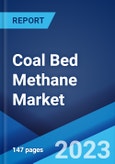Coal bed methane (CBM) is a natural, colorless, and odorless hydrocarbon gas, which is absorbed into the solid matrix of the coal. It is obtained from unconventional gas reservoirs by transforming plant material into coal. Its extraction process usually involves minimal risk of explosion hazards in underground coal mines. As a result, it is used as an alternative source of energy in gas turbines for power generation worldwide.
Coal Bed Methane (CBM) Market Trends:
A considerable surge in electricity consumption around the world due to improving income levels and increasing construction of residential homes represents one of the key factors bolstering the growth of the market. This can also be attributed to the growing electrification of heat and buildings and the escalating demand for digitally connected devices. Moreover, the rising adoption of cost-effective and green fuels on account of increasing environmental concerns and stringent government policies on greenhouse gas (GHG) emissions is driving the demand for CBM across the globe. CBM can be converted into diesel, gasoline, or compressed natural gas (CNG), which are commonly used as biofuels in automobiles. Apart from this, CBM is utilized in the production of methanol that finds diverse applications in wastewater treatment and the chemical industry. Furthermore, the escalating usage of CBM as a feedstock for manufacturing fertilizers and plastics is providing lucrative opportunities to manufacturers for expanding their consumer base in the agriculture industry. Besides this, the rising need for clean-burning fuels is further influencing the adoption of CBM in industrial applications, such as cement production, rolling mills, and steel plants, which is projected to strengthen the market growth in the coming years.Market Segmentation:
This report provides an analysis of the key trends in each segment of the market, along with forecasts at the global, regional, and country levels for 2025-2033. The report categorizes the market based on type, technology, and application.Breakup by Type:
- CBM Wells
- Coal Mines
Breakup by Technology:
- Horizontal Drilling
- Hydraulic Fracturing
- CO2 Sequestration
Breakup by Application:
- Power Generation
- Residential
- Commercial
- Industrial
- Transportation
Breakup by Region:
- North America
- United States
- Canada
- Asia-Pacific
- China
- Japan
- India
- South Korea
- Australia
- Indonesia
- Others
- Europe
- Germany
- France
- United Kingdom
- Italy
- Spain
- Russia
- Others
- Latin America
- Brazil
- Mexico
- Others
- Middle East and Africa
Competitive Landscape:
The competitive landscape of the industry has also been examined along with the profiles of the key players being Arrow Energy Holdings Pty Ltd., Baker Hughes Company, BP PLC, Essar Group, G3 Exploration, Halliburton Company, Petroliam Nasional Berhad (PETRONAS), Reliance Industries Limited, Royal Dutch Shell plc, Santos Limited and The ConocoPhillips Company.Key Questions Answered in This Report
1. How big is the Coal Bed Methane (CBM) market?2. What is the expected growth rate of the global Coal Bed Methane (CBM) market during 2025-2033?
3. What are the key factors driving the global Coal Bed Methane (CBM) market?
4. What has been the impact of COVID-19 on the global Coal Bed Methane (CBM) market?
5. What is the breakup of the global Coal Bed Methane (CBM) market based on the type?
6. What is the breakup of the global Coal Bed Methane (CBM) market based on the technology?
7. What is the breakup of the global Coal Bed Methane (CBM) market based on the application?
8. What are the key regions in the global Coal Bed Methane (CBM) market?
9. Who are the key players/companies in the global Coal Bed Methane (CBM) market?
Table of Contents
Companies Mentioned
- Arrow Energy Holdings Pty Ltd.
- Baker Hughes Company
- BP PLC
- Essar Group
- G3 Exploration
- Halliburton Company
- Petroliam Nasional Berhad (PETRONAS)
- Reliance Industries Limited
- Royal Dutch Shell plc
- Santos Limited
- The ConocoPhillips Company
Table Information
| Report Attribute | Details |
|---|---|
| No. of Pages | 142 |
| Published | May 2025 |
| Forecast Period | 2024 - 2033 |
| Estimated Market Value ( USD | $ 20.7 Billion |
| Forecasted Market Value ( USD | $ 29.8 Billion |
| Compound Annual Growth Rate | 4.1% |
| Regions Covered | Global |
| No. of Companies Mentioned | 11 |








